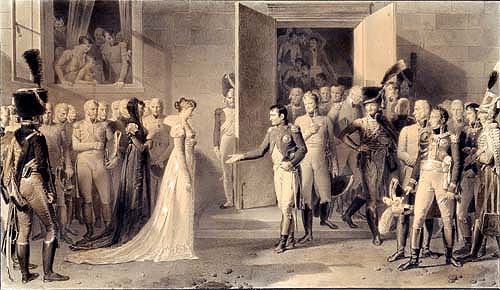In his amassing of titles over the years, Isabey became successively: painter and draughtsman for His Majesty’s cabinet; painter and draughtsman for ceremonies and foreign relations; organiser of public festivals and fêtes at the Tuileries; draughtsman of the Seal and of Titles; first painter of the Empress Josephine’s chamber; decorator for the imperial theatres; and drawing teacher to the Empress Marie-Louise, in which role he succeeded Prud’hon. This latter job brought him welcome security and his pleasant nature made him soon very popular with Napoleon’s new wife; as a close acquaintance of Josephine’s, he had been concerned about his position after the annulement.
Decked as he was with titles and also privileged to have the monopoly on miniature portraits of Napoleon, for the most part destined for diplomatic presents, Isabey executed during the Empire period several large-format sepia drawings, some of which were exhibited at the Salons, notably: The First Consul’s visit to the manufactory of the frères Sévène in Rouen in 1804 and The Emperor’s visit to the Oberkampf manufactory, in Jouy in 1806.
Of much smaller dimensions, The arrival of Marie-Louise in Compiègne presents the arrival of Marie-Louise in France with rather more decorum than what happened in reality. The presentation of the daughter of the Emperor of Austria to the Emperor of the French was supposed to take place in Soissons, on 27 March 1810, at a reception organised by the municipality. However, giving in to impatience, Napoleon rushed to head off the future Empress on the Soissons road, leaped from his carriage to join her at a post house, hurried through the municipal ceremony, and on reaching the Château de Compiègne – where the court was anxiously awaiting the couple – rapidly presented his new bride to those present before disappearing with her into their apartments.
Isabey painted the new Empress several times. Indeed, at the Salon of 1810 two watercolour portraits of Marie-Louise and Napoleon in their marriage costume were displayed; they were subsequently sent to Francis I of Austria (Schatzkammer, Kunsthistorisches Museum, Vienna). In 1811, the birth of the King of Rome, gave him the opportunity to commemorate the scene of the presentation of the child by the new mother to Napoleon. He also produced miniatures and in 1812 executed a portrait of Marie-Louise crowned with roses, typical of the flattering, soft-focus style that seduced so many female sitters of the late Empire and Restoration period.
Karine Huguenaud (tr. P.H.), updated 12 December 2024, RY.
January 2005


